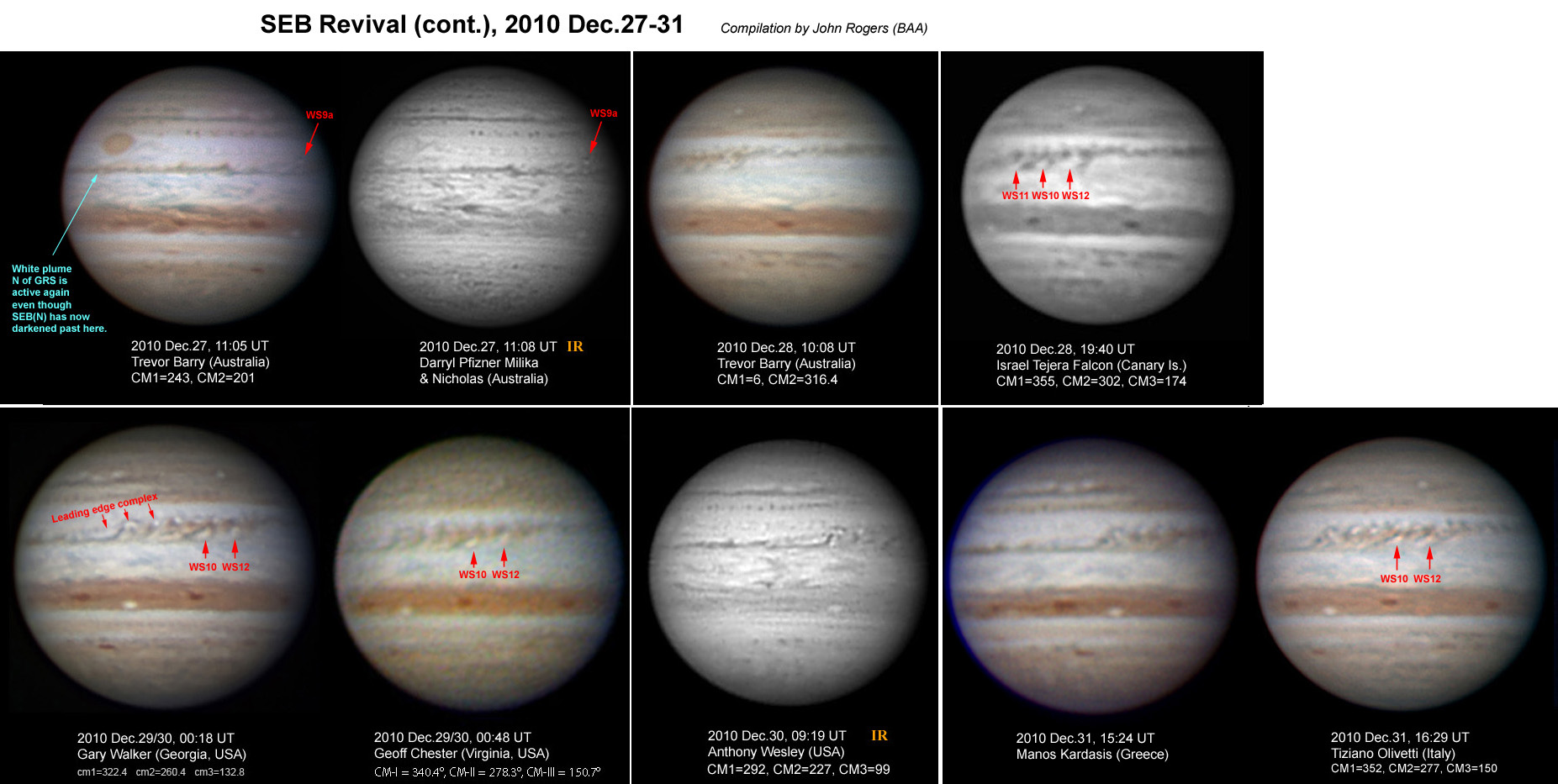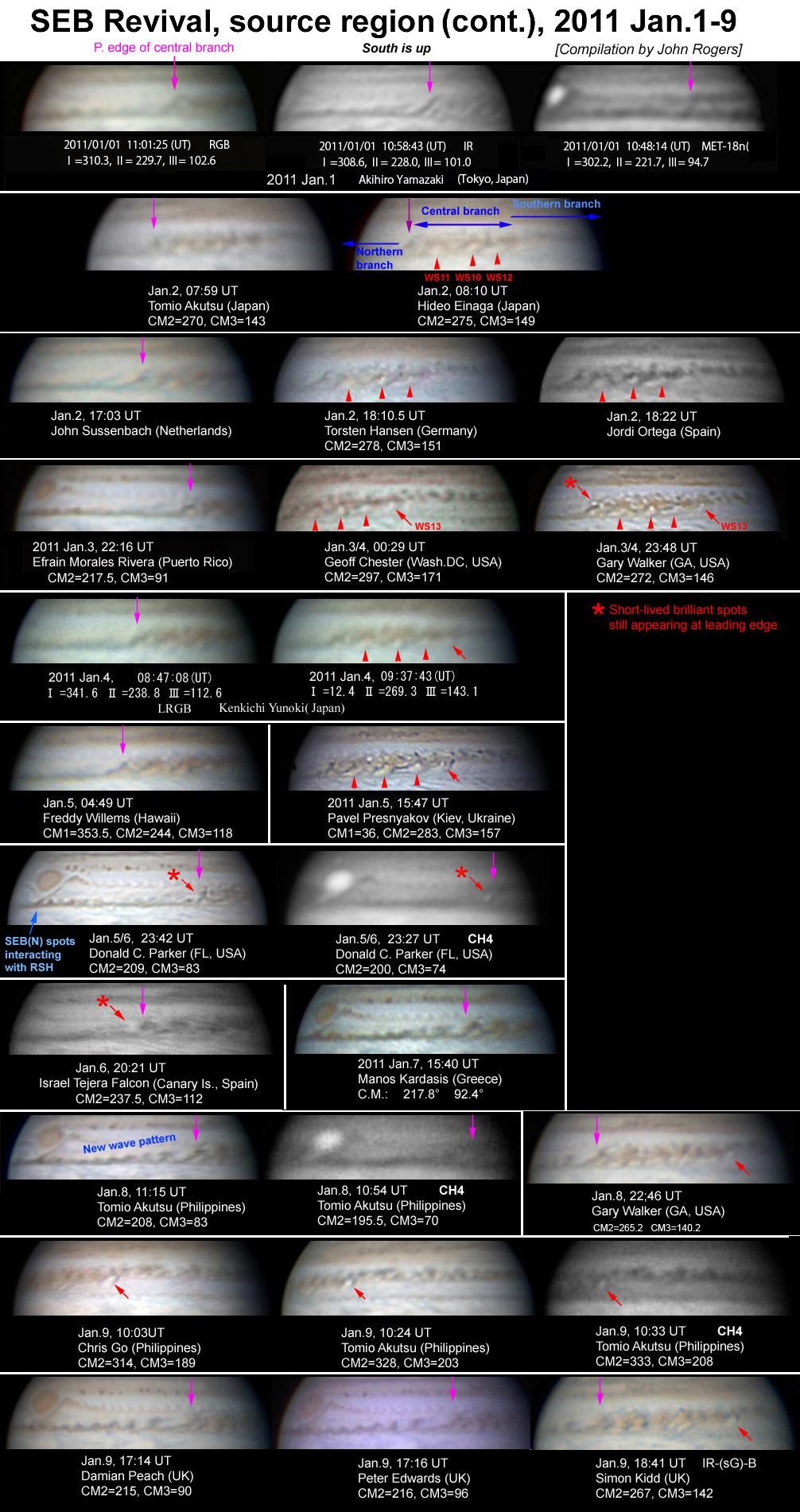| SEB Revival update to Jan.9 by John H.Rogers |
Here is another update on the SEB Revival. I hope all this isn't overloading your inboxes: this may be the last complete set to send, as there is now great activity all round the planet. Do keep observing it as much as possible, and esp. the GRS from Jan.17 onwards!
Update on SEB Revival: 2010 Dec.27-31 and 2011 Jan.1-9
The SEB Revival is continuing energetically, with all three branches now highly active in the same manner as historical examples. Attached are three more compilations of images: two covering the source and central branch, and one covering the southern branch.
In the source set, red arrowheads indicate the previous 3 bright spots which appeared at or near the source: WS11, WS10, WS12. It seems that the whole of the central branch is divided into large comma-shaped cells, each of which encloses the space around one of these plumes, and includes the plume itself if still bright, dark blue-grey streaks marking the Sp. and Nf. edges, and a reddish-brown cloud on the S side.
A new white spot appeared at the source on Jan.3/4 (WS13; L2 = 294), and was methane-bright on Jan.9, though not as bright as the earlier plumes in the Revival.
The leading edge of the central branch continues to be well-defined, with occasional small bright spots appearing along it. On Jan.5, there was a dramatic change in the large, pale blue-grey wedge which had usually been present just p. this leading edge: it suddenly broke up into a series of waves spaced ~6 deg apart. This occurred within only 20 hours! Could it be due to an atmospheric wave causing simultaneous breakup of the top cloud layer over this whole region? Over the next few days, the waves became much darker and grey, and spread out in the p. direction so the spacing was ~9 deg. by Jan.9, down to the GRS. Meanwhile, also on Jan.5, dark features on the SEB(N) started to interact with the adjacent Red Spot Hollow, which is thereby darkening, and the bright plume N of the GRS is being displaced.
The third compilation of images shows the southern branch - the reviving SEB(S)-- from Dec.31 to Jan.9. JUPOS data showed a speed of +4 deg/day for the early spots in the southern branch. Various dark spots are labelled with different marks, in red or purple, in an attempt to track them visually. There seems to be no clear evidence of a latitudinal gradient of drift rate across the reviving SEB(S). Instead, some spots change their intensities quickly, making long-term tracking difficult. Nor do the dark spots have clearly organised structures. Tiny very dark spots, first clearly shown in Anthony Wesley's infrared image on Dec.31, could perhaps be little vortices, and they have apparently developed into the spots which are presently darkest. The leading edge of the southern branch is difficult to define exactly, as the leading dark projections have faded, but the darkness has become concentrated in one very large and dark spot, which should arrive at the p. edge of the Red Spot Hollow around Jan.17.
Observations of all regions are still very important, and especially of the GRS from



John H. Rogers,Ph.D.
Jupiter Section Director,
[British Astronomical Association.]
●SEB復活、1月9日までの更新 皆さんへ、 これはSEB復活の新たな更新である。皆さんのinboxに負担を掛けないことを願う。 現在、木星全周に大きな活動があるので、これが送ることができる完全なセットの 最後かもしれない。できる限り、特に1月17日以降の大赤斑を観測し続けて欲しい。 ________________________________________________________________ ●SEB復活の更新、2010年12月27-31日と2011年1月1-9日 SEB復活は、歴史的な例と同じように、3つの分枝全てが高い活動を示して、活発に 続いている。添付したのは3枚の組画像で、2枚は発生源と中央分枝をカバーし、 1枚は南分枝をカバーしている。 発生源セットには、発生源やその近くに出現した以前の3個の白斑WS11,WS10,WS12を 赤矢印で示す。中央分枝全体は、それぞれがプルームの1つの周りの空間を囲んで いる、大きなコンマ形のセルに分割されていて、今も明るいならばプルーム自身や、 南前端と北後端を示す暗青灰色のストリークや、南端の赤茶色の雲が含まれている ように見える。 新しい白斑(WS13; L2 = 294)が1月3/4日に出現したが、復活の初期のプルームほど 明るくないけれども、1月9日にはメタンブライトであった。 中央分枝の先端(leading edge)は引き続いて形がはっきりとしていて、それに沿って 時々小さな白斑が出現している。1月5日には、この先端の直前に通常存在していた、 大きな淡い青灰色のくさびに、劇的な変化があった。くさびは約6度離れた波の シリーズに突然分裂した。これはたった20時間以内に起こった! この領域全体の 雲頂レイヤーの同時崩壊を引き起こした大気中の波によるものだろうか? 次の数日間に、波はさらに暗く灰色になり、1月9日までに間隔が約9度になって、 大赤斑の下へ向かって前方に拡がった。一方、1月5日にも、SEB(N)の暗い模様が 隣接する大赤斑孔(Red Spot Hollow)と相互作用を始め、そのために大赤斑孔は 暗化して、大赤斑の北の明るいプルームは取って代わられている。 3番目の組画像は12月31日〜1月9日の南分枝、復活するSEB(S)を示す。JUPOSデータ から、南分枝の初期暗斑は+4度/日の速度を示す。視覚的に追跡できるように、 様々な暗斑には赤や紫の異なるマークでラベルを付けている。復活するSEB(S)を 横切るドリフトの緯度勾配のはっきりとした証拠は見当たらない。それどころか、 いくつかの暗斑はすばやく濃度を変えて、長期の追跡を難しくしている。でも、 暗斑ははっきりと構造を形成している訳ではない。12月31日のAnthony Wesleyの 赤外画像で初めてはっきりととらえられた、小さな非常に暗い暗斑はおそらく小さな 渦であるだろうが、現在最も暗い暗斑に明らかに発達した。南分枝の先端は、先頭の 暗いプロジェクションが淡化したので、正確に決めることは難しいが、暗さは1つの 非常に大きな暗斑に集中してきて、1月17日以降に暗斑は大赤斑孔の前端に到達する。 全ての領域を観測することは今も重要であるが、特に1月17日以降に大赤斑を観測 することは重要である。 John H. Rogers, Ph.D. Jupiter Section Director, British Astronomical Association 【日本語訳:伊賀祐一】
ALPO-Japan Latest
Jupiter Section